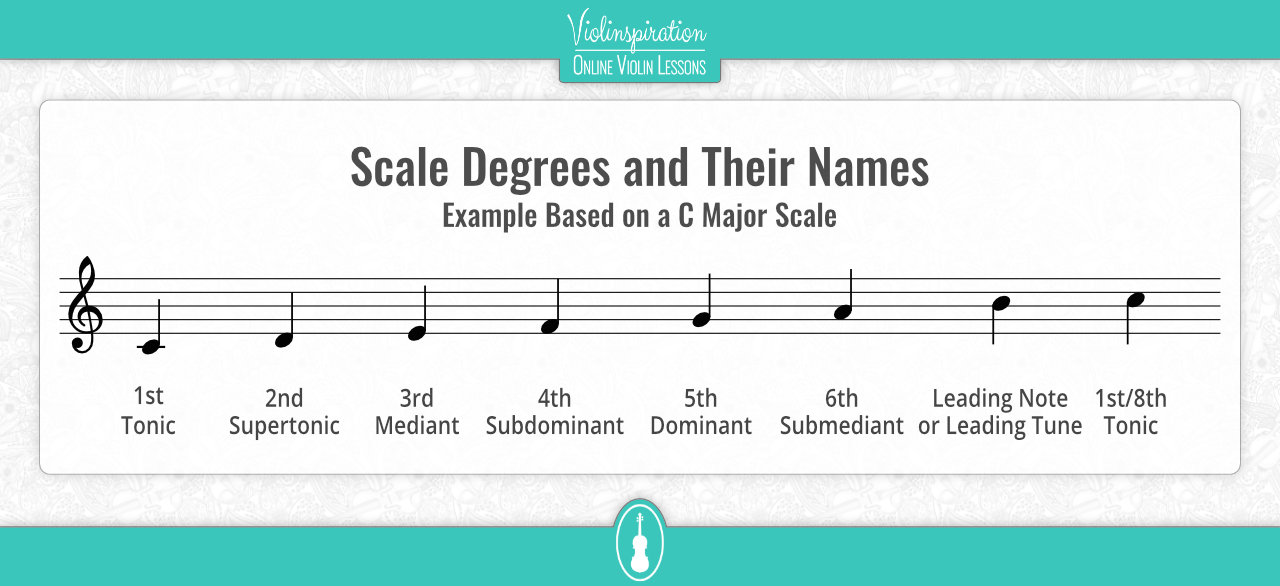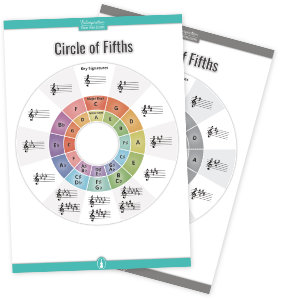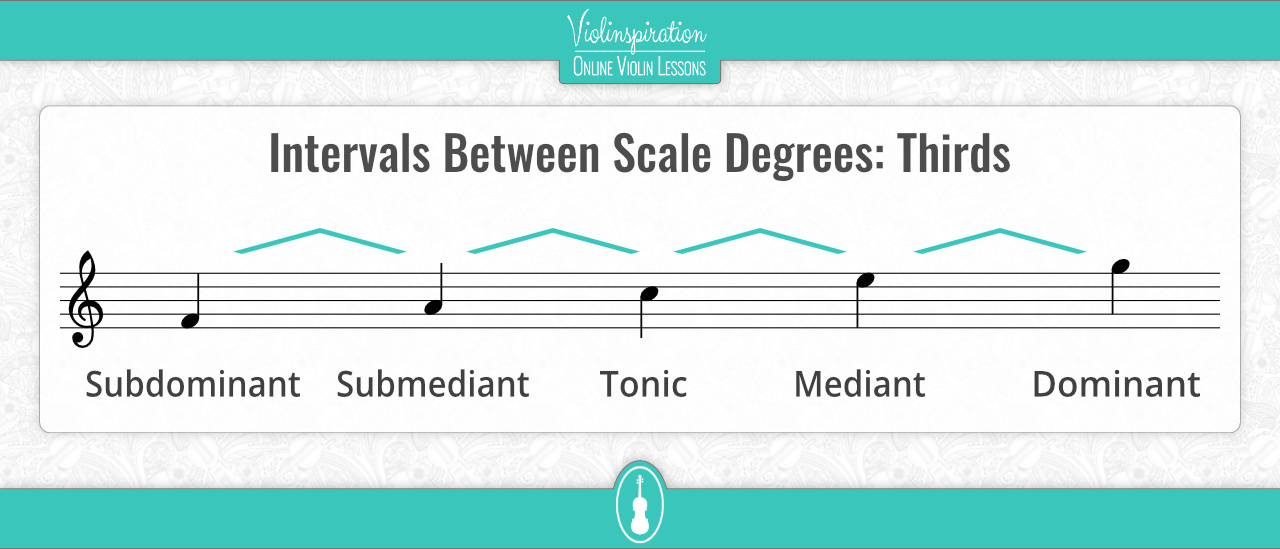In music theory, names of scale degrees refer to the position of a note in a scale, starting with the tonic as the first note. Each note in a scale is assigned a number, known as its scale degree, and is named accordingly.
These scale degrees have specific functions within a scale, and understanding their names and meanings helps in analyzing and composing music and adding musicality to your pieces when you play the violin. Each scale degree contributes to the overall musical structure, melodic movement, and harmonic progression of a musical piece.
By knowing the scale degree names and how they function, musicians can better understand and communicate about the different elements of music theory, such as chord progressions, melodies, and harmonies, providing a common language and framework for discussing music, both in theory and practice.
Now, let’s take a look at the names of scale degrees, their functions, and their importance!

How Many Scale Degrees Are There?
There are seven scale degrees that are corresponding to the seven notes in a mode or scale. Both major and minor scales have the same number of scale degrees.
What Are the Names of the Seven Scale Degrees?
- The first degree: Tonic
- The second degree: Supertonic
- The third degree: Mediant
- The fourth degree: Subdominant
- The fifth degree: Dominant
- The sixth degree: Submediant
- The seventh degree: Leading tone or leading note
Take a closer look at the scale degrees and their names on the example of the C Major scale.

What Do You Call the 8th Scale Degree?
The 8th degree of the scale is the tonic but one octave higher.
You can sense a resolution leading up to it from the seventh degree of the scale, which is why we call the seventh degree of the scale the leading note.
When you reach the 8th degree, you can start counting from the beginning again.
Scale Degree Names in Order and Their Function
Let’s add to the information above by learning more about each scale degree and the importance of their function in building a scale.
Tonic
The first scale degree is called the tonic. It is the most important note of a scale and tells us what key we are in, and that’s why it is also called the keynote of a scale. It serves as the reference point and provides stability and resolution.
Also, if you know what is the key signature of a piece, you directly know it is tonic. For example, the A Major scale with three sharps in the key signature starts with the A note and that’s the tonic of this scale.
If you want to get more familiar with different key signatures, make sure to download your copy of the circle of fifths:

Printable Circle of Fifths
color and grayscale version
Super Tonic
The second scale degree gets its name from the Latin word super, meaning above. This special name, supertonic, means above the tonic note.
The super tonic is always one whole step above the first degree.
Mediant
Coming in as the third scale degree, the mediant is in the middle of the tonic and the dominant. It moves the music forward from the keynote to the other notes in the scale.
The mediant note is called such because it is the middle note of a triad chord that we form when we play the first, third, and fifth notes of a scale together. These three notes are very special because they form an arpeggio and they sound so beautiful when played together or one after the other!
Subdominant
The fourth scale degree often creates a sense of tension or anticipation.
The prefix sub means below, so the subdominant is the note of the scale below the dominant note but also it is a perfect fifth away from the tonic note above while the dominant – spoiler – is the perfect fifth away above the tonic.
So, the subdominant is the “lower dominant” when we look at more than one octave.

Dominant
The fifth scale degree holds a strong and stable position, a dominant position, in the order of the scale and often leads back to the tonic, creating a sense of resolution as it forms the perfect fifth with the first scale degree, which is the most commonly used interval in Western music.
Submediant
The sixth scale degree, submediant, ordinarily serves as a transition note between the dominant and the tonic. It is in the middle between the subdominant and the tonic.
Similar to the subdominant, it is the “lower mediant” when we take a look at more than one octave of a scale. Both submediant and mediant are a third away from the tonic.

Leading tone or Leading note
The leading note or tone of a scale is the seventh scale degree. It is a half step lower than the tonic in a major scale and usually leans to resolve the tonal center preparing you for the keynote, the tonic.
The Seventh Scale Degree in a Natural Minor Scale: Subtonic
In the case of a natural minor scale and also in a descending melodic minor scale, the second to last note is a whole step below the tonic so it has a different name: the subtonic.
All the other scale degree names are the same in a minor scale.
How Do You Remember Names of Scale Degrees?
A good way to remember the scale degrees is to break them down into smaller groups, understand their meaning, and practice regularly. This may seem challenging at first, but there are a few techniques that can help make it easier.
Memorize them in groups
Instead of trying to memorize all the scale degrees at once, break them down into smaller groups.
For example, you can start by memorizing the first three degrees: tonic, supertonic, and mediant, and then move on to the next three. This method can help you focus on a smaller set of information at a time, making it easier to remember.
Understand the meaning of each name
Each scale degree name has a purpose and function in music theory, and understanding their definition can help you remember them.
For example, the dominant (5th scale degree) has a strong “pull” towards the tonic (1st scale degree) because of its interval relationship with the tonic. This relationship creates a sense of harmonic tension and resolution which is fundamental to creating music that is pleasant to hear.
Practice regularly
The more you practice and use the information, the easier it will be to remember.
Try playing scales and saying the scale degree names out loud. You can also practice recognizing the different scale degrees within a piece of music.
You may also like…
I hope this explanation clarifies the meaning and importance of scale degrees.
If you would like to learn more about music theory, you may also like the following articles:
- Violin Note Reading for Beginners – How to Read Sheet Music on the Violin – learn to read sheet music from scratch
- Violin Sight Reading – Practice Methods and Exercises – get to know what are the most effective methods for learning sight reading violin sheet music
- Half Steps and Whole Steps – Music Theory in a Nutshell – learn a little bit about intervals between notes.
























